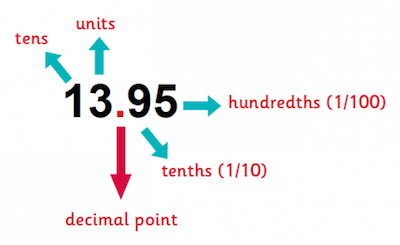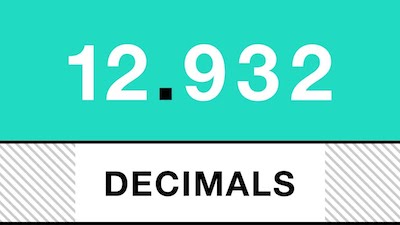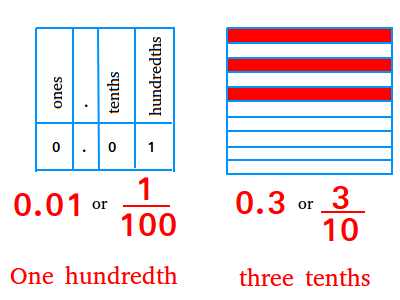There’s no question that one of the most important concepts of the number system is decimals and fractions. As you probably already know, they actually mean the same while they are expressed in different ways.
Discover everything you need to know about fractions.
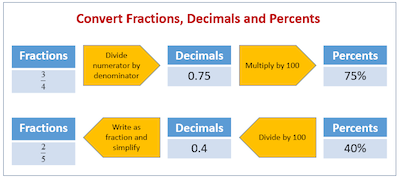
Simply put, there are 2 types of numbers:
#1: Integers:
These refer to whole numbers, both positive and negative. They don’t have any fractional component. Some examples include -1, -4, -99, 4, 78, 93.
#2: Decimals:
These refer to numbers that have both an integer and a non-integer part and they are separated by a decimal point. Some examples include 2.5, 9.647, 345.98. Notice that the part after the decimal point is known as the fractional part and the part before the decimal point is the whole number part.
It’s also important that you keep in mind that decimals can appear in the form of decimals or in the form of fractions. For example, 0.5 can be written as 5/10 which can then be reduced to a simpler fraction: 1/2.
So, What About Percentages?
Simply put, percentages refer to decimal numbers to the base 100 and they are represented by a % (percent sign). For example, 35% when converted into fraction will be 35/100. This can be written as 0.35 in decimal terms.
As you can see, the 3 concepts – decimals, fractions, and percentages, share a strong inter-relationship.
Check out our fraction to percentage calculator.
Decimals To Fractions To Percentages – The Relationship Between Them
#1: Converting Decimals To Fractions:
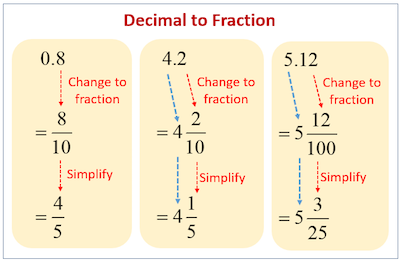
Step 1: Write the decimal number as the numerator.
Step 2: Remove the decimal point.
Step 3: In the denominator write 1 followed by number of zeros equal to the number of digits that were there after the decimal point.
Step 4: Reduce the number to the lowest form.
Here’s an example: Convert 62.520 to a fraction
Step 1 and 2: Write 62.520 as 62520 in the numerator
Step 3: Write 1000 in the denominator
Step 4: 62520/1000 should be reduced to the lowest form which will be 1563/25
#2: Converting Fractions To Decimals:
Make the numerator as the dividend and the denominator as the divisor. Now it becomes a simple division problem. The quotient derived will be the answer. This way you can convert a fraction to decimal in a step-by-step manner.
Here’s an example: Convert 7/25 into a decimal
25)70(0.28
50
———
200
200
———
0
In the above example, 7 became the dividend and 25 became the divisor. It was solved like a normal division problem, as shown. 0.28, which is the quotient, is the decimal format of the fraction 7/25, and thereby the final answer.
Step 1: Multiply the numerator and the denominator by the same number so that the denominator becomes a multiple of 10
Step 2: Write the top number by properly adjusting the point. The number of digits after the point must be equivalent to the number of zeros in the denominator.
This way you can convert a fraction to decimal in a step-by-step manner.
Looking for a percent to faction online calculator?
#3: Converting Fractions To Percentages:
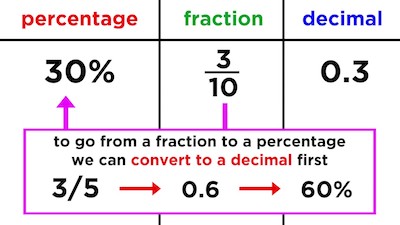
Step 1: Make the numerator as the dividend and the denominator as the divisor. Now it becomes a simple division problem.
Step 2: Multiply the quotient by 100.
This way you can convert a fraction to percentage in a step-by-step manner.
Here’s an example: Convert 12/25 into a percentage
25)120(0.48
100
———
200
200
———
0
In the above example, multiply 0.48 by 100 which becomes 48. This will be represented as 48%.
#4: Converting Percentages To Fractions:
Step 1: Remove the percent sign and write 100 in the denominator
Step 2: If the percent is not a whole number, then multiply both top and bottom by 10 for every number after the decimal point.
Step 3: Simplify to the reduced form
This way you can convert a percentage to a fraction in a step-by-step manner.
Here’s an example: Convert 50% into a fraction
Step 1: Write 50% as 50/100.
Step 2: 50 is a whole number so step 2 can be skipped.
Step 3: 50/100 can be reduced to 1/2 which is the answer.
#5: Converting Decimals To Percentages:

Step 1: Multiply the decimal by 100 or simply shift the decimal point 2 steps towards the right and attach a percent sign.
This way you can convert a decimal to percentage in a step-by-step manner.
Here’s an example: Convert 5.1 into a percentage
Step 1: Perform 5.1*100 which will result in 510%.
Discover our decimal to fraction calculator. [ https://fractioncalculation.com/decimal-to-fraction-calculator/ ]
#6: Converting Percentages To Decimals:
Step 1: Remove the percent sign and write 100 in the denominator
Step 2: Remove the denominator and place the decimal point in the numerator by 2 places to the left
This way you can convert a percentage to a decimal in a step-by-step manner.
Here’s an example: Convert 35% into a decimal
Step 1: Write 35% as 35/100.
Step 2: 35/100 will be written as 0.35

